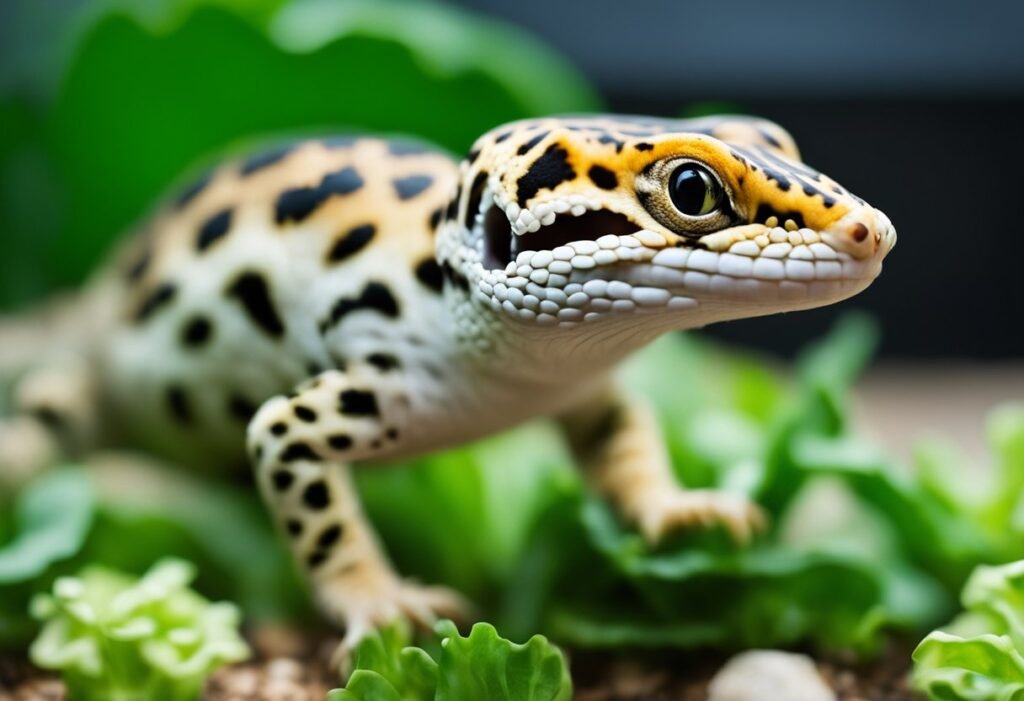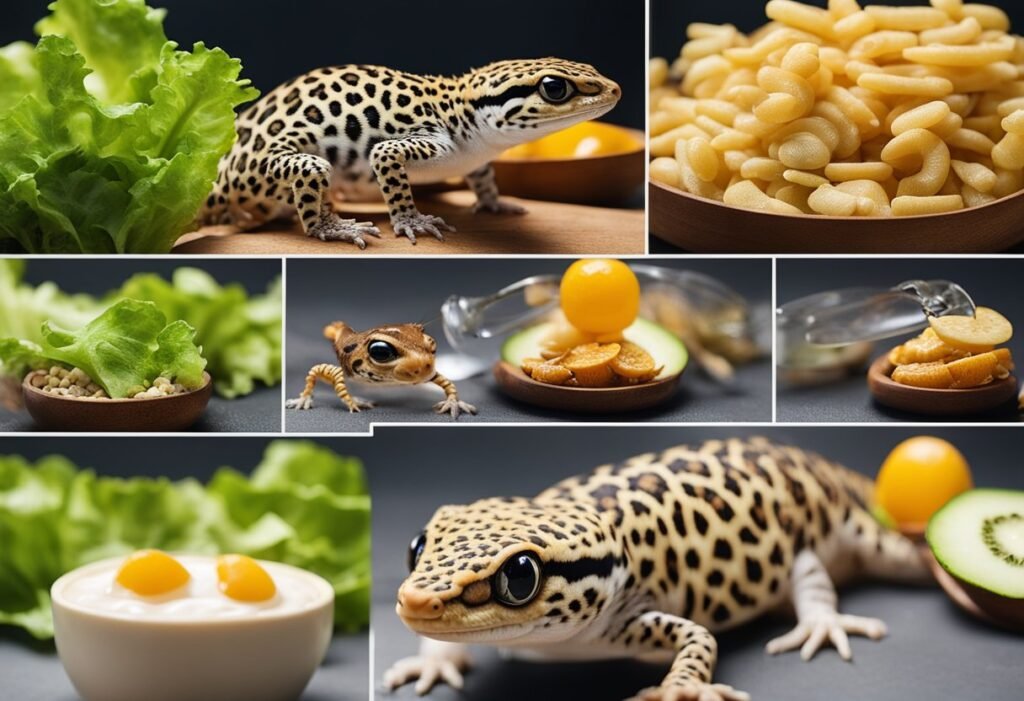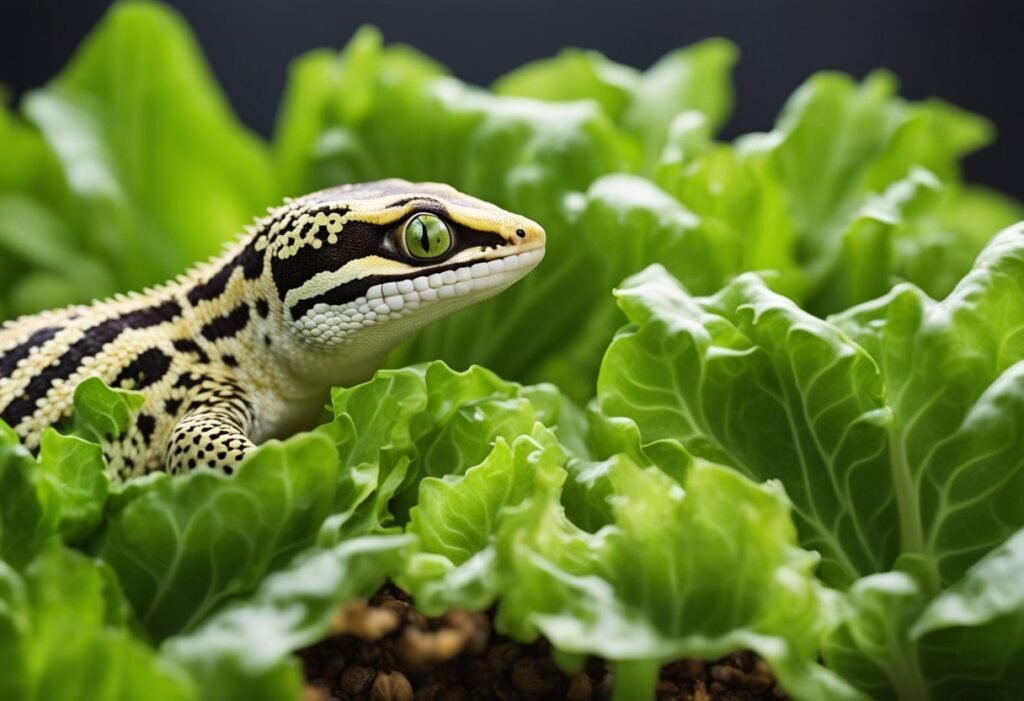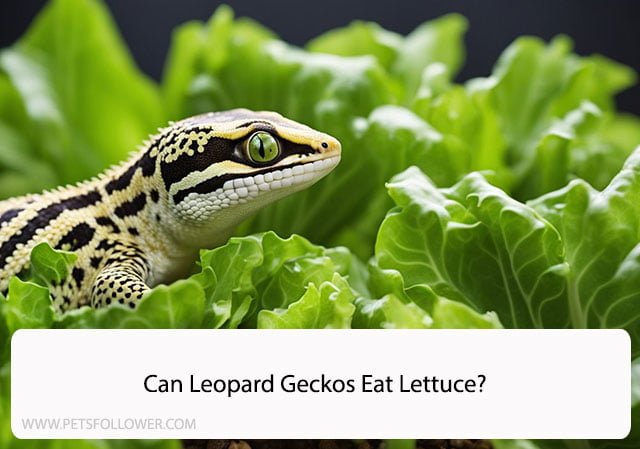Leopard geckos are one of the most popular reptile pets around the world. They are easy to care for and have a docile temperament that makes them a great choice for beginners. However, as with any pet, it’s important to know what they can and cannot eat to keep them healthy. One of the common questions that people ask is whether leopard geckos can eat lettuce.
Lettuce is a popular leafy green vegetable that is often used in salads and sandwiches. It’s a good source of vitamins and minerals for humans, but can it be beneficial for leopard geckos? The short answer is no. In fact, feeding lettuce to leopard geckos can be harmful to their health. In the next paragraphs, we will explain why lettuce is not a suitable food for leopard geckos and what other foods you can offer them to ensure they get the nutrients they need.
Leopard Gecko Dietary Basics

As responsible pet owners, it is important to ensure that our leopard geckos receive a balanced and nutritious diet. In this section, we will discuss the nutritional requirements of leopard geckos and the safe foods that can be included in their diet.
Nutritional Requirements
Leopard geckos are insectivores, which means that their diet should consist mainly of insects. They require a diet high in protein and low in fat. It is important to ensure that the insects are gut-loaded, which means that they are fed a nutritious diet before being fed to the leopard gecko. This ensures that the leopard gecko receives all the necessary nutrients.
In addition to insects, leopard geckos also require calcium and vitamin D3 to maintain healthy bones. Calcium can be provided through calcium supplements or by dusting the insects with calcium powder before feeding them to the leopard gecko. Vitamin D3 can be obtained through exposure to UVB lighting or by providing a supplement.
Safe Foods for Leopard Geckos
While leopard geckos require a diet high in protein, there are certain foods that should be avoided. Lettuce, for example, should not be fed to leopard geckos as it has little nutritional value and can cause digestive problems. Other vegetables and fruits should also be avoided as they can be difficult for leopard geckos to digest.
Safe foods for leopard geckos include crickets, mealworms, waxworms, and roaches. These insects should be gut-loaded and dusted with calcium powder before being fed to the leopard gecko. It is important to vary the diet to ensure that the leopard gecko receives all the necessary nutrients.
In conclusion, leopard geckos require a diet high in protein and low in fat. Insects should be gut-loaded and dusted with calcium powder before being fed to the leopard gecko. Lettuce and other vegetables and fruits should be avoided. By providing a balanced and nutritious diet, we can ensure that our leopard geckos remain healthy and happy.
Lettuce and Leopard Geckos
When it comes to feeding leopard geckos, it’s important to provide them with a balanced and varied diet. While insects are the mainstay of their diet, some owners may wonder if they can also feed their geckos lettuce. In this section, we will explore the nutritional value of lettuce and the potential risks of feeding it to leopard geckos.
Nutritional Value of Lettuce
Lettuce is a leafy green vegetable that is low in calories and high in water content. It contains a variety of vitamins and minerals, including vitamin A, vitamin K, folate, and potassium. However, lettuce is not a significant source of protein, which is essential for leopard geckos.
While lettuce can provide some nutritional benefits for leopard geckos, it should not be a staple in their diet. Instead, it can be offered as an occasional treat or as a way to add variety to their diet.
Risks of Feeding Lettuce
While lettuce is generally safe for leopard geckos to eat in small amounts, there are some potential risks to consider. One of the main concerns is that lettuce contains a high amount of water, which can cause diarrhea in leopard geckos if fed in excess. This can lead to dehydration and other health problems.
Another risk of feeding lettuce to leopard geckos is that it contains a low amount of calcium and a high amount of phosphorus. This can disrupt the calcium-to-phosphorus ratio in their diet, which is essential for maintaining healthy bones and preventing metabolic bone disease.
In conclusion, while lettuce can provide some nutritional benefits for leopard geckos, it should not be a staple in their diet. Instead, it can be offered as an occasional treat or as a way to add variety to their diet. When feeding lettuce, it’s important to monitor their intake and avoid feeding it in excess to prevent health problems.
Alternative Foods for Leopard Geckos

Leopard geckos are insectivores, which means their diet primarily consists of insects. However, it is important to provide them with a variety of food options to ensure they receive all the necessary nutrients. Here are some alternative food options for leopard geckos.
Insects and Feeder Options
Leopard geckos can eat a variety of insects, including crickets, mealworms, waxworms, and superworms. It is important to offer a variety of insects to prevent boredom and ensure a balanced diet. It is also important to gut load the insects before feeding them to your leopard gecko. Gut loading involves feeding the insects a nutritious diet before feeding them to your leopard gecko. This ensures that your leopard gecko receives the necessary nutrients from the insects.
Another feeder option for leopard geckos is dubia roaches. Dubia roaches are high in protein and low in fat, making them a healthy option for leopard geckos. They are also easy to digest and have a soft exoskeleton, making them easy for leopard geckos to eat.
Supplements and Vitamins
In addition to a variety of insects, leopard geckos require supplements and vitamins to ensure they receive all the necessary nutrients. Calcium and vitamin D3 are essential for leopard geckos to maintain healthy bones and prevent metabolic bone disease.
One way to provide calcium and vitamin D3 is by dusting the insects with a calcium and vitamin D3 supplement before feeding them to your leopard gecko. Another option is to provide a calcium and vitamin D3 supplement in a dish in your leopard gecko’s enclosure.
It is important to provide supplements and vitamins in the correct amounts. Too much calcium can be harmful to leopard geckos, so it is important to follow the recommended dosage.
In conclusion, providing a variety of insects and feeder options, as well as supplements and vitamins, is essential for a leopard gecko’s health and well-being. By offering a balanced diet and ensuring proper supplementation, you can help your leopard gecko live a long and healthy life.
Feeding Practices for Leopard Geckos
When it comes to feeding your leopard gecko, it is important to keep in mind that these reptiles are carnivores and require a diet high in protein. While it may be tempting to offer your gecko a variety of fruits and vegetables, it is important to remember that these foods do not provide the necessary nutrients for their health and can even be harmful.
Feeding Schedule
Leopard geckos should be fed once a day, in the evening, as they are nocturnal animals. We recommend offering live insects such as crickets, mealworms, and dubia roaches as the main component of their diet. It is important to ensure that the insects are appropriately sized for your gecko, as feeding them insects that are too large can lead to digestive issues.
In addition to live insects, you can also offer your gecko occasional treats such as waxworms or superworms. However, these should only be given in moderation as they are high in fat and can lead to obesity if overfed.
Portion Control
When feeding your leopard gecko, it is important to practice portion control to ensure they are not overfed. As a general rule, we recommend offering 2-3 appropriately sized insects per feeding. It is important to monitor your gecko’s weight and adjust the amount of food accordingly.
In summary, feeding your leopard gecko a diet high in protein and practicing portion control are crucial for their health and well-being. While it may be tempting to offer them a variety of foods, it is important to stick to their natural diet to ensure they receive the necessary nutrients.
Recognizing and Preventing Health Issues

Leopard geckos are generally hardy and easy to care for, but they can still develop health issues if their diet is not balanced. In this section, we will discuss some common health issues that can arise from improper feeding and how to prevent them.
Signs of Nutritional Deficiencies
Leopard geckos require a diverse diet to obtain all the necessary nutrients. A diet that is deficient in certain nutrients can lead to health problems. For example, a lack of calcium can cause metabolic bone disease, which can result in weakened bones and deformities.
To prevent nutritional deficiencies, we should provide a varied diet that includes insects, such as crickets and mealworms, as well as fruits and vegetables. However, we should avoid feeding our leopard geckos lettuce, as it contains little nutritional value and can even cause digestive problems.
Obesity and Overfeeding
Leopard geckos are prone to obesity if they are overfed or fed a diet that is too high in fat. Obesity can lead to health problems, such as fatty liver disease and shortened lifespan.
To prevent obesity, we should feed our leopard geckos appropriately sized meals that are not too frequent. We should also avoid feeding them high-fat foods, such as waxworms, on a regular basis.
In conclusion, by recognizing the signs of nutritional deficiencies and preventing obesity, we can help ensure our leopard geckos stay healthy and live a long life.
Frequently Asked Questions
What alternative foods are safe for leopard geckos besides insects?
Leopard geckos are primarily insectivorous, meaning that they require a diet consisting mostly of insects. However, they can also eat other small animals, such as mealworms, waxworms, and crickets. It is important to make sure that any alternative foods you provide are appropriate for the size and age of your leopard gecko and that they are not too high in fat or protein.
Are there any vegetables that are suitable for leopard geckos to consume?
While leopard geckos are primarily insectivores and do not require vegetables in their diet, they can be offered small amounts of leafy greens and vegetables, such as collard greens, kale, and carrots. However, it is important to remember that vegetables should not make up a significant portion of a leopard gecko’s diet.
Is it safe for leopard geckos to eat fruits, and if so, which ones?
Leopard geckos can eat small amounts of fruit, such as papaya, mango, and banana, as an occasional treat. However, fruit should not make up a significant portion of a leopard gecko’s diet, as it is high in sugar.
What is the primary diet of leopard geckos?
The primary diet of leopard geckos consists of insects, such as crickets, mealworms, and waxworms. It is important to provide a variety of insects to ensure that your leopard gecko is receiving a balanced diet.
What are the dietary preferences of leopard geckos?
Leopard geckos have a strong preference for live prey and may not eat dead insects. They also prefer insects that are smaller than the width of their head and may have difficulty eating larger prey.
Why might a leopard gecko exhibit licking behavior towards humans?
Licking behavior in leopard geckos is often a sign of curiosity or exploration. It is not a sign of affection, as leopard geckos do not form strong bonds with humans. If your leopard gecko is exhibiting excessive licking behavior, it may be a sign of stress or illness and should be evaluated by a veterinarian.





